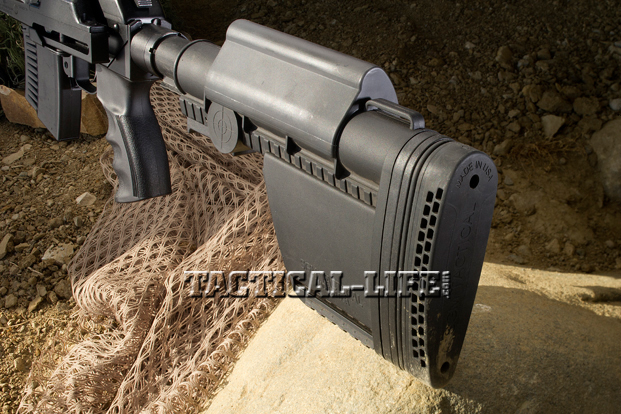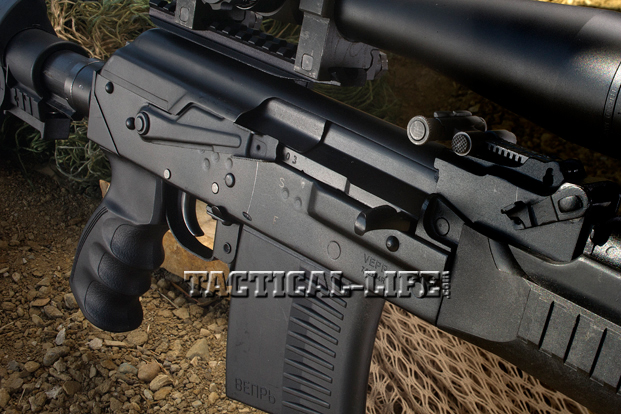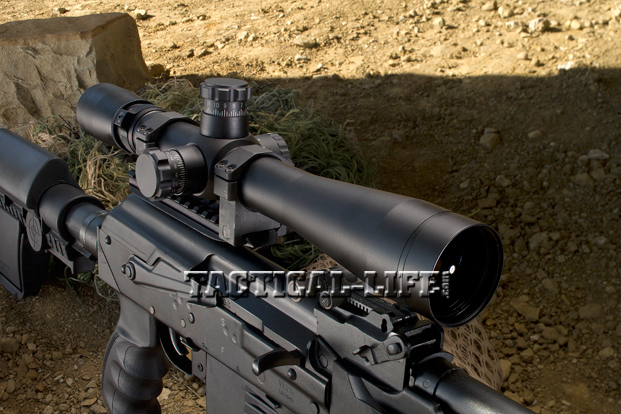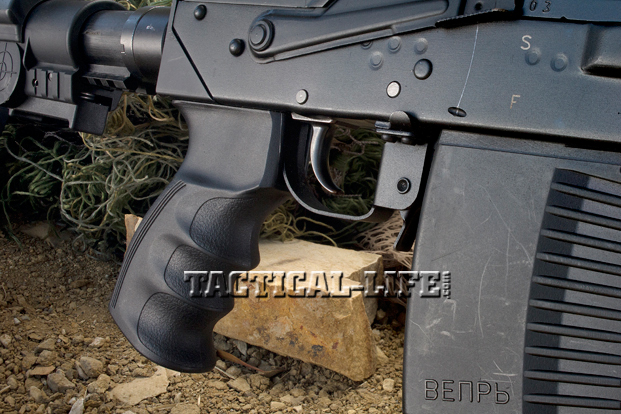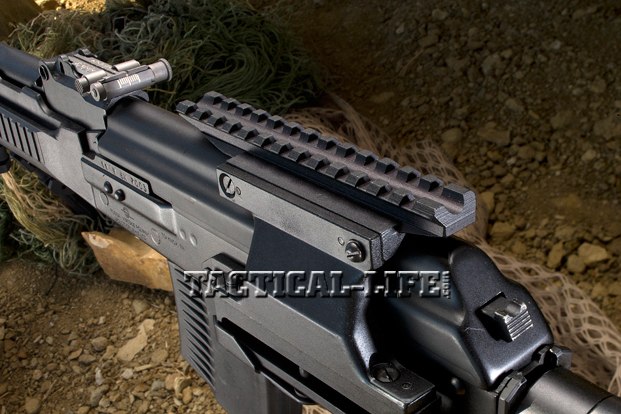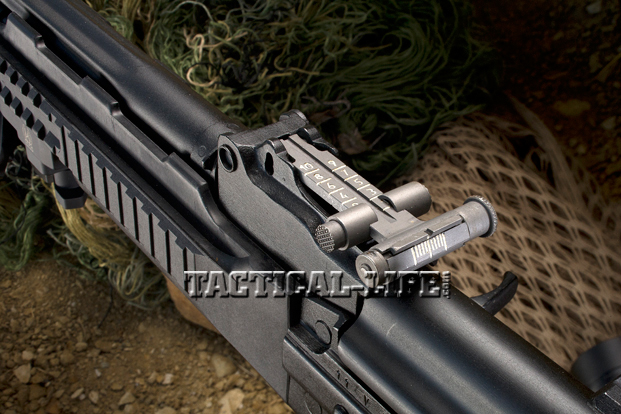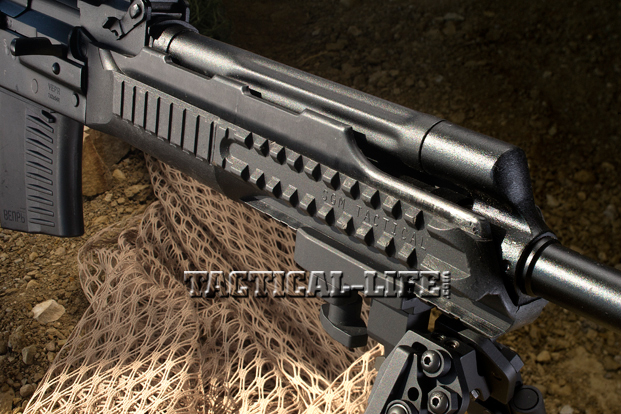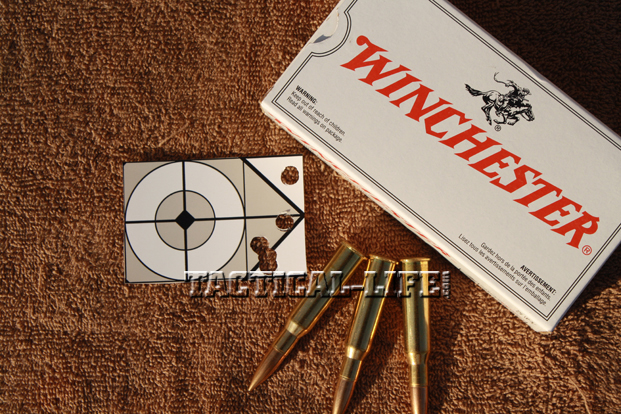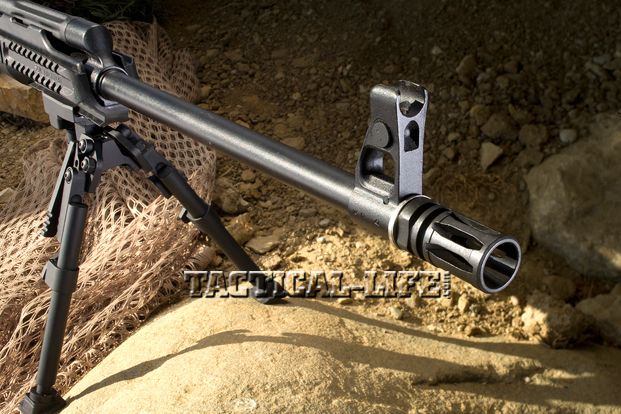A long the banks of the Vyatka River and approximately 400 miles east of Moscow, far away from the reaches of any invading army lies the MOLOT factory. It is the lifeblood of Vyatskie Polyany, a small industrial city, and has been in the firearms business since World War II, producing some 2.5 million PPSh submachine guns. During the ensuing Cold War, MOLOT was the sole producer of the Russian RPK machine gun, a beefed-up AK-47 that filled the role of the squad automatic weapon in infantry units. After the fall of the Soviet Union, the factory reinvented itself and used its existing equipment and firearms design-and-engineering base to make civilian semi-auto rifles. Thus the VEPR was born, retaining the rugged reliability and stronger receiver of its RPK progenitor.
Wolf Performance Arms VEPR rifles are available in a variety of calibers and configurations, but none carry the historical weight of the 7.62x54R cartridge. First introduced in 1891, the same year that a young Czar Nicholas II survived an assassination attempt while on an official state visit in Japan, it has the distinction of being the oldest military cartridge still in continuous use, including in the ubiquitous bolt-action Mosin-Nagant rifle, in more modern belt-fed machine guns and in the SVD sniper rifle. This fact guarantees plentiful and inexpensive ammunition supplies. With a ballistic performance similar to that of the .30-06 Springfield and the 7.62mm NATO rounds, the 7.62x54R is popular with hunters too. Unfortunately precision shooters do not have easy access to real Russian SVD sniper rifles (more commonly known as Dragunovs), but the VEPR offers an excellent-quality sibling. Imported by Wolf Performance Arms (WPA), related to but independent from Wolf Ammunition, VEPR rifles can be had in plain-Jane, importable, thumbhole, wood-stocked versions or be tricked out after arriving in the U.S.
Like all traditional AK pattern rifles, the VEPR uses a long-stroke gas-piston method of operation, where the bolt and piston rod move together as one big unit. This is a lot of mass slamming back and forth as you fire, which can have a negative impact on accuracy—a shift in point of aim is common. The advantage, however, is greater reliability. This is one of the main reasons for the AK’s reputation of mediocre accuracy and high reliability.
Advertisement — Continue Reading Below
When this same system is used for the 7.62x54R cartridge, which is significantly larger than the 7.62x39mm the RPK was originally designed for, and with a proportionally larger bolt and operating rod, the effect on accuracy is exacerbated. The VEPR compensates for this in several ways. As mentioned, it uses a standard stamped receiver that has been beefed up for heavy use and is notably thicker on both sides. The VEPR also uses a heavy-duty front trunnion, which is where the barrel connects to the receiver and where the bolt locks. This makes the receiver much stronger with less flex when fired.
Gun Details
The VEPR I received boasted a heavy, 23-inch, hammer-forged target barrel with a chrome-lined chamber and bore. This process forms the barrel around a mandrel, to provide durability and a very precise internal finish with sharp lands and grooves. The gas cylinder and bolt support rod are also chrome-lined for long-term durability and corrosion resistance. For mounting optics, the VEPR has a standard Russian scope rail-mount on the left side of receiver. WPA included an extra-low-profile, side-mount Picatinny rail with the sample rifle. This all-steel mount is made by MOLOT and has never been available in the U.S. until now. It is specifically designed to mount a scope over the top of an AK-variant rifle along the centerline (rather than offset) and as low as possible on the receiver cover. This creates a better cheekweld. The scope mount is low enough, in fact, that the iron sights remain visible over the top. WPA also made several upgrades to this rifle. The wooden stock was replaced with an SGM Tactical Stock Kit, which required the use of a special adapter to fit the VEPR’s angled rear trunnion. This tough glass-filled Zytel collapsible stock has an adjustable length of pull that varies from 14.5 to 18 inches and features a thick rubber pad that reduces perceived recoil by as much as 50 percent. The length-of-pull adjustment system uses a Picatinny-based slide for a dozen different settings and includes a locking tab to retain the desired length. The stock also contains internal storage space for batteries and a cleaning kit, an ambidextrous cheekrest, a top-mounted sling-attachment point, and a length of Picatinny rail at the bottom for attaching a monopod or sling mount. The wooden pistol grip has also been replaced with the ATI Strike Force pistol grip, which is far more ergonomic and offers a textured surface. This grip is also made from a tough glass-reinforced polymer and is very comfortable.
The checkered wooden handguard was replaced with the SGM Tri-Rail, originally designed for the Saiga 12 gauge shotgun and custom fit to the VEPR. This handguard has Picatinny rail at the 3, 6 and 9 o’clock positions for adding a bipod as well as lights or lasers. The rail also includes a smooth surface area toward the back for comfort and is made from HTN/50 polymer. Finally WPA added a K-Var trigger set for 922(r) compliance.
The fit and finish on the rifle was outstanding, better than I have seen on any other AK-pattern rifle. The markings are distinct and well executed. The standard AK right-side-mounted safety is effective if rudimentary, and the magazine release is of the usual narrow steel-paddle variety. The rifle ships with two polymer, five-round, single-stack magazines, which worked well but took a bit of effort to top off. Unlike for the SVD or even the Romanian PSL (which is much closer in design to the VEPR), 10-round magazines are unavailable for the VEPR. There is no denying that this is a large rifle, which is 43 inches long with the stock collapsed and weighs 10.5 pounds empty. The iron front sight is of the elevated AK-variety and mounted toward the front of the barrel. The rear sight is elevation-adjustable from 100 to 300 meters. Despite the rifle’s overall length and weight, it is well-balanced and handles easily. Like most AKs, the bolt does not have a hold-open device or lock open on the last shot. The VEPR should not be confused with an actual Dragunov sniper rifle, which is capable of improved accuracy and uses a very different short-stroke gas-piston system. The VEPR is much closer in design to the Romanian PSL sniper rifle, which is also built on an RPK receiver and uses the traditional AK long-stroke gas piston system. Both the SVD and PSL were designed for platoon-level designated marksmen and widely equipped across infantry units. Rather than being precision, specialized sniper rifles, they were always more intended as long-range support weapons for disruptive effect and suppressive fire. Both rifles were equipped with 4x scopes, rather than the much-higher-power scopes familiar to Western snipers. The PSL in particular did not have the accuracy requirements of the SVD—1 to 3 MOA is fairly standard.
Advertisement — Continue Reading Below
Range Time
For range-testing I equipped the VEPR with the Weaver Tactical CIRT (Close-Intermediate Range Tactical) scope. This excellent and compact optic features 1-5x24mm variable power with an illuminated, adjustable-intensity, red/green, first-focal-plane, glass-etched reticle. (Glass-etching the reticle ensures that there is nothing to come loose under shock or recoil. And placing the reticle at the first focal plane causes it to grow or shrink as magnification is increased or decreased, keeping the reticle in proper perspective for use in rangefinding.) The horizontal crosshairs are segmented in mils, and the center circle and dot are measured at the size of a human head at 100 yards. Another advantage to this optic is that, even if the battery goes dead, the scope will function with its standard reticle. As is to be expected from a duty optic, the Weaver Tactical CIRT features solid, one-piece construction and fully multi-coated lenses, is waterproof and shockproof, and comes with argon-gas-purged 30mm tubes to prevent fogging. Longer-range shooters may prefer a higher power scope, but for most sport-shooting applications I found that 5x was plenty. I used this setting for accuracy testing as well, and I fired from a benchrest using a Harris bipod and sandbag rear rest at 100 yards with several different types of U.S. commercial and Russian Wolf ammunition. I experienced no feeding or extraction problems of any sort. Despite the full-sized cartridges, the recoil was extremely manageable and comparable to firing a .308 caliber AR rifle. Firing the rifle off-hand was also very comfortable, although with no flash suppressor there is quite a bit of muzzle blast. The trigger was standard for an AK, with a single-stage 4.5-pound pull and slightly less than a half-inch of travel. The end result in terms of accuracy was on par with Warsaw Pact expectations. My best group was just over 1.5 MOA, although the average across all types of ammunition used was closer to 3 MOA.
Final Thoughts
The VEPR is a very unique rifle designed around an incredibly sturdy receiver platform and with a distinctive Russian heritage. Those with a particular appreciation for the AK pattern will find much to admire in this hard-hitting and well-built rifle. Also, with the many tactical upgrades built into it by WPA, it more closely resembles modern-day Russian military marksman rifles. The continued use of the 7.62x54R round guarantees a steady supply of suitable ammunition. For more information, visit wolf-arms.com or call 865-233-4801. ★

